|
|
|
|
|
Intel Clarkdale |
|
Join the community - in the OCAU Forums!
|
Synthetic Benchmarks, Discrete Graphics Performance
SYNTHETIC BENCHMARKS
All following tests are done with the P55 based DK55KG motherboard and a single HD 4870 graphics card. We used 2 well-known synthetic benchmarks for this review: SANDRA 2009 and PCMark Vantage.
SiSoftware Sandra is a system analyzer that includes benchmarking, testing and listing modules. We selected 3 subtests: Processor Arithmetic, Processor Multimedia, and Memory Bandwidth. The Processor Arithmetic test shows how the processor handles arithmetic (MP Dhrystone / MIPS) and floating point instructions (MP Whetstone / MFLOPS). The multimedia benchmark shows how the processor handles MMX and SSE instructions used for multimedia processing. In both benchmarks the 661 shows a massive improvement over the E8600. This is the impact of the far more efficient Nehalem micro architecture. Memory bandwidth improved by around 40% as well, due to moving the memory controller on-die. But have a look at the i7 920. Thanks to its fast quick path interconnect it is still by far delivering the highest bandwidth. Clarkdale and Lynnfield are both running with a slower DMI bus.
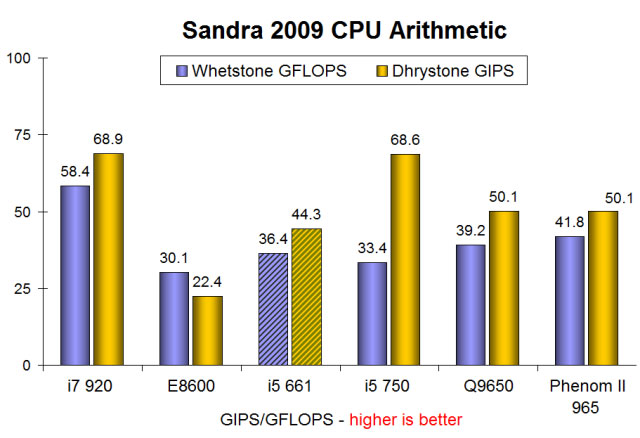
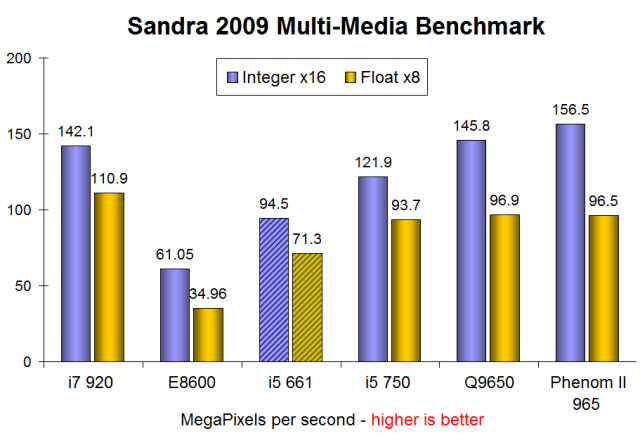
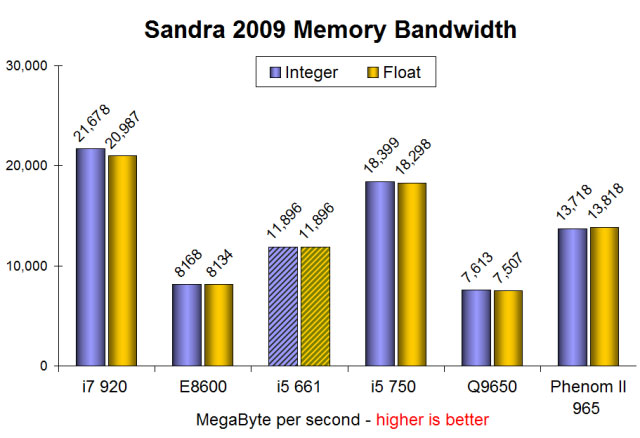
The “PCMark Suite” is a collection of various single- and multi-threaded CPU, Graphics and HDD tests representing common desktop tasks such as viewing and editing photos, video, music and other media, gaming, communications, productivity and security. The final score reflects the system performance a typical desktop user would expect when running those applications. The subtests are covering data encryption, decryption, compression and decompression, GPU and CPU image manipulation, video playback, editing and transcoding, audio playback and transcoding, GPU and CPU game tests, game data loading, web page rendering, mail operations, contacts search, text editing and HDD tests. It takes more than an hour to complete the PCMark suite. It is the most comprehensive and representative benchmark we know of for a desktop system. The 661 comes out on top in the PCMark Suite, scoring around 5% better than the next best processor, the 920. Are you surprised that a medium level dual core processor is beating a high-end quad core processor like the 920? There is a good explanation: Many PCMark tests are running single-threaded, and those that run multi-threaded seem to be limited to 4 threads. That’s the reason why the 750 and 920 perform head-to-head, even though the 920 is capable of running 8 threads. As the 661 is at 3.33 GHz far higher clocked than all 3 Intel quad-core CPUs we tested with and at the same time capable of running 4 threads by virtue of HT, it seems to be the best suited processor for this benchmark. We hold PCMark in high regard, because it comprehensively and realistically simulates desktop usage. It's also important to note that the i5 661 performs in this benchmark around 30% better than its predecessor, the E8600.
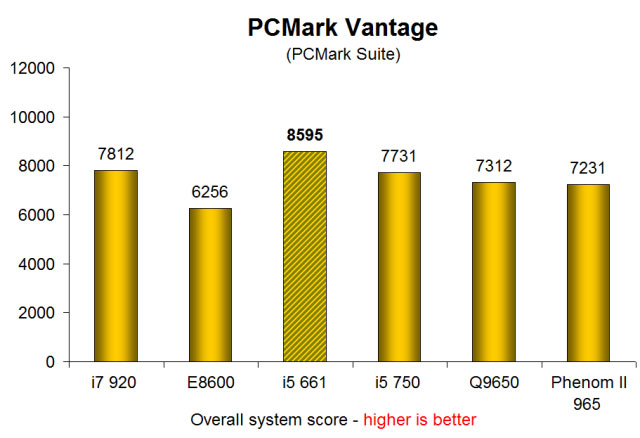
GAMING PERFORMANCE WITH DISCRETE GRAPHICS
As mentioned earlier, we expect gaming enthusiasts will prefer to disable the onboard graphics of Clarkdale and instead add a separate video card to the system. So in this section we will test that configuration with the HD 4870 and our various CPUs. We are using here the same games and settings as for the GMA HD test. All games were benchmarked at resolutions of 1280 x 1024 and 1920 x 1200 with medium quality / medium detail settings and AA/AF disabled. Performance was measured as average frames per second with “FRAPS”. The lower resolution is certainly not the way you run 3D games these days unless you have an entry-level graphics card. But such relatively low resolution allows us to better differentiate between processor performance. At higher resolutions the GPU is almost always the bottleneck so the advantage of a faster CPU is less.
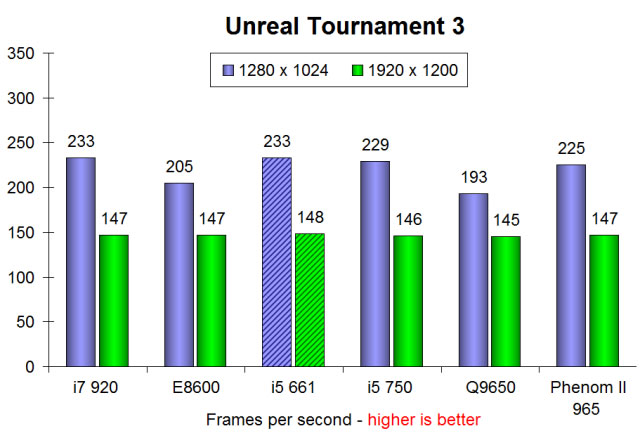

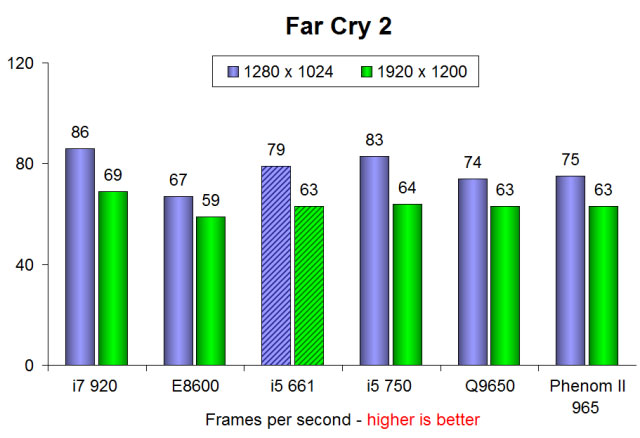
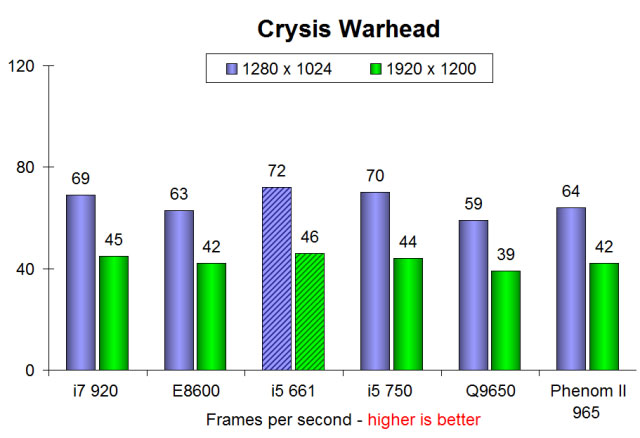
As to be expected the 661 is in all 4 games well ahead of its dual core predecessor E8600. The gain is rather small in 1920 x 1200 but more pronounced in 1280 x 1024. The more “CPU-bound” a game is, the bigger is the gain with the 661. In particular Unreal Tournament loves extra CPU power. In 1280 x 1024 the 661 gains 15% on the E8600. Both dual core CPUs, even the “older” E8600, perform very well when playing 3D games. 4 physical cores are still not much of an advantage for current 3D games, but CPU frequency is. As both dual core CPUs are running at 3.33 GHz, well above the 3 Intel quadcore CPUs, they perform at least as good as the quadcore CPUs. In fact, the 661 proved to be the best performing CPU in 3 of the 4 games we tested.
|
|
Advertisement:
All original content copyright James Rolfe.
All rights reserved. No reproduction allowed without written permission.
Interested in advertising on OCAU? Contact us for info.
|

|


